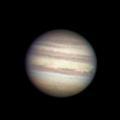Planets of the Solar System
Comparative Planetology covers the interiors, surfaces and atmospheres of the planets and moons in our Solar System, starting with the Earth and moving out through the terrestrial and Jovian planets to the icy worlds at the edge of the system. The planets Mars and Venus have their own geological and atmospheric processes, similar in many ways to those on Earth, but also quite different in others. The larger moons of Jupiter and Saturn also have complex histories and processes occurring in their interiors either now or in the distant past.
 Here at the Astrophysics Research Institute we run a selection of life-long learning courses that can be taken by students who do not have any specialist scientific or mathematical background. These courses are taken as part time distance learning courses; you do not need to attend any on-site classes.
Here at the Astrophysics Research Institute we run a selection of life-long learning courses that can be taken by students who do not have any specialist scientific or mathematical background. These courses are taken as part time distance learning courses; you do not need to attend any on-site classes.
The course is split into the following sections:
- The Formation of the Solar System: What are the current theories concerning the formation of the solar system? What key factors determine the original make-up of a planet's core? What processes create the landforms we see on other worlds? How does a planet's atmosphere evolve over time?
- The Terrestrial Planets: Why has the Earth's evolved so differently from the atmospheres' of Venus and Mars? What role does the presence of water play in the evolution of terrestrial atmospheres? Could the environment of Mars have permitted life to evolve there in the distant past? How long ago did Mars have liquid water on its surface and could there be any liquid water today? What does the atmosphere of Venus tell us about the likely consequences of global warming here on Earth? What evidence is there for ice at the poles of the Moon and Mercury and what are the similarities and differences between them?
- The Jovian Planets: How are the structures of the Jovian planets different to those of the terrestrial planets? What causes the giant storms and cloud belts on Jupiter? What is the origin of the famous Great Red Spot? Why are the cloud belts on Saturn less prominent than those on Jupiter? What effect does Uranus' axial tilt have on its atmospheric dynamics? Why is the atmosphere of Neptune so dynamic when it is so far from the Sun?
- The Satellites of the Jovian Planets: How closely do the atmospheres of the outer planet's satellites compare to the terrestrial planets? What causes the volcanic emissions on Io, and how are they different to those on Earth? What is the origin of the oxygen detected in the atmospheres of Europa and Ganymede? What lies beneath the dense atmosphere of Saturn's moon Titan and why does it have such a thick atmosphere? How similar are the worlds of Pluto and Titan?
The course lasts for five months. You will be expected to produce two pieces of coursework and one multiple-choice test over the Internet throughout the course. Overall we expect that you will need to put around 100 hours of time into the course.
